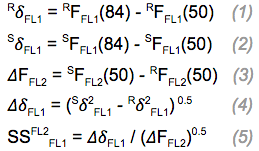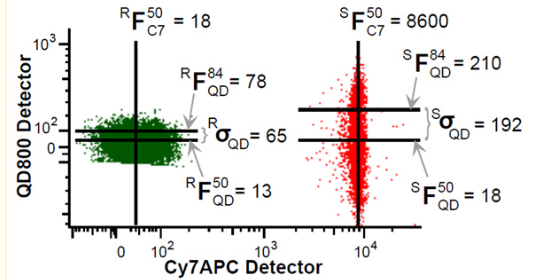The Spillover Spreading Matrix (SSM) is a measure of the performance of an instrument for a given panel. It reflects the Poisson-based error in fluorescence quantification.
SSM’s can be calculated for a set of single stain controls in the Compensation Editor. This tool works for matrices created in FlowJo, as the single stain controls are needed to calculate several statistics from to produce each value in the SSM.
Calculating an SSM
To generate a spillover spreading matrix in FlowJo visit the compensation editor, select the matrix of interest, and click the “SSM” button:

The Calculation
Spillover spreading is construed as the impediment of signal detectable above background, and is intrinsic to the configuration of a given instrument. The spillover spreading for a given detector/spillover-color pair can be calculated empirically by taking the square root of differences in squared robust standard deviations of measured fluorescence intensity from unstained negative and singly stained positive control populations:

Where:
- R stands for ‘Reference’, meaning the FL2- population in this example
- S stands for ‘Stained’, meaning the FL2+ population in this example
- Sigma is standard deviation (adjusted to use 84th and 50th percentile)
- F is fluorescence in units of intensity
Here is a graphical example of those measures from Nguyen et. al.1

These values can be calculated for each detector staining pair, resulting in the spillover spreading matrix. The values within this matrix are not a percentage, but represent a standard deviation of spillover, AKA signal spread. The values in these matrices are directly comparable, though they only describe one part in a complex system which contributes to the quality of a flow panel.
Why Calculate SSM
- Quality control of instrument sensitivity – Since signal spreading directly effects channel sensitivity and results between similarly configured machines are readily comparable, the SSM can be used as a benchmark of configuration and performance quality control.
- Panel optimization – Immunofluorescence panel design becomes exponentially more complex as researchers utilize increasingly more channels of detection in their experiments. The SSM calculation helps point the way to maximize useful signal.
- Comparison between different instrument configurations – The measurement gives a PI or SRL manager the ability to quantifiably contrast between different cytometers and/or alternate arrangements of a given cytometer.
